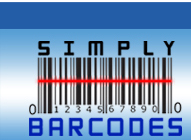
Bar CodesThere are dozens of types of bar codes in use throughout the world today for a variety of purposes. UPC bar codes are one of the most common types of bar codes. The UPC code is the 12-digit numerical codes used on retail products in North America. Then there is the EAN bar code, which is the 13-digit bar code used on retail products throughout the rest of the world. There are PostNet bar codes used on U.S. Mail, SCC and SSCC codes used on product shipments, Code 39 and Code 128 used for a variety of purposes such as inventory tagging, and many more. One way in which bar code types differ is the size of bar code required to store a given amount of information. To illustrate this concept, think of a bar code like a font. Using the Arial Narrow font, you can make the numbers 12345 look like this: The same holds true for bar codes. Take a look at the images below. We stored the exact same information (12345) in several types of bar codes:
Most bar codes appear as vertical lines, often in black on white. These bar codes are referred to as one-dimensional (or 1D) bar codes since they are read across. Other bar codes look like a checkerboard. These are called two-dimensional (2D) bar codes because they are read across and up/down at the same time. 2D bar codes are increasingly popular because of their capability to store large amounts of information in a very small space. However, 2D bar codes can only be read by newer model bar code scanners that have the ability to read both left/right and up/down at the same time. Another differentiating factor between bar code types is their capability to store different type of information. Some codes store just numbers, others store both numbers & letters and yet other codes allow the encoding of all characters. Some bar code types only accept a certain number of digits. UPC bar codes, for example, encode exactly 12 numbers. EAN bar codes encode exactly 13 numbers. Interleaved 2 of 5 bar codes encode an even number of numerical digits. For additional discussion on more specific bar code topics, please see the other sections of our bar code guide. To request more information regarding barcodes in general or any of our services, please call us at 1-877-872-2060 (toll-free) or 1-404-885-6066. Please note that this short tutorial was designed as an introduction for the lay person. It is not meant as a comprehensive guide to all of the capabilities, technical concerns, or other implications of bar codes. |
||||||||
For more information regarding UPC codes / barcodes: Call 877-872-2060 (toll-free) or 1-404-885-6066 (international) testimonials | UPC Barcode Guide | UPCcode.net - Site Map barcodes for dvd | barcodes for cd | barcodes for books | barcodes for magazines | barcodes for amazon |
Page Topic: UPC Codes, Bar Codes, Barcode, UPC Barcode



